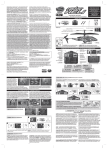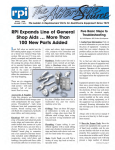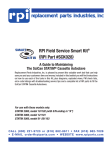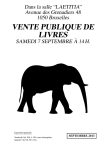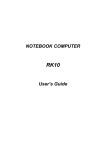Download rpi field service calibration kit
Transcript
An ISO 9001 Certified Company RPI FIELD SERVICE CALIBRATION KIT RPI Part #MIK074 For servicing the Midmark • Ritter Ultra Clave® For use with these models only: M9 (S/N Series: CZ, DA, DB, DX, DY, FD & OM) M9D (S/N Series: FF & FG) M11 (S/N Series: ES, ET, FP, FR & GB) M11D (S/N Series: GC & GC) CALL (800) 221-9723 or (818) 882-8611 • FAX (818) 882-7028 • E-MAIL [email protected] • WEBSITE www.rpiparts.com This guide has been prepared to help troubleshoot, evaluate and repair the Midmark•Ritter M9 and M11 Ultra-Clave®. TABLE OF CONTENTS 1.0 – Leak Detection Guide . . . . . . . . . . . . . . . . . . . . . . . . . . . . . . . . . . . . . . . . . . . . . . . . . . . . . . . . . . . . . . . . . . . . . . . . . . . . . . . . . . . . . . 2 Identifies areas in which leaks are most likely to occur. 2.0 – Planned Maintenance (PM) Check List . . . . . . . . . . . . . . . . . . . . . . . . . . . . . . . . . . . . . . . . . . . . . . . . . . . . . . . . . . 3 Lists step-by-step instructions for replacing most common PM parts including door gasket, dam gasket, filters and door spring. 3.0 – Error Codes and Other Diagnostics . . . . . . . . . . . . . . . . . . . . . . . . . . . . . . . . . . . . . . . . . . . . . . . . . . . . . . . . . . . . . 4-6 Provides explanation of error codes as well as other diagnostic tools including a fuse chart, drying cycle dip switch settings information, and service tips focusing on a low water error and inactive display lights. 4.0 – Door Opening Test Procedure . . . . . . . . . . . . . . . . . . . . . . . . . . . . . . . . . . . . . . . . . . . . . . . . . . . . . . . . . . . . . . . . . 7 Provides a test to verify if the door opening relay on the main PC board is functioning. 5.0 – Calibration Procedure – Pressure/Temperature Potentiometer Adjustments . . . . . . . . . . . . . . . . . . . . . . . . . . . . 8-14 Offers step-by-step, detailed calibration procedures as well as an at-a-glance version. 6.0 – RPI Parts to fit Midmark • Ritter M9 & M11 Ultra-Clave . . . . . . . . . . . . . . . . . . . . . . . . . . . . . . . . . . . . . . . . . . . . 15 Listing of RPI parts that fit the Ultra-Clave and includes the OEM Part # for easy reference. 1 1.0 - LEAK DETECTION GUIDE DOOR and/or DAM GASKET Check for water or steam leaking around the door. VENT SOLENOID VALVE Check for water or steam leaking back into the reservoir through the condensing coil. FILL SOLENOID VALVE Check for water leaking back into the reservoir through the fill line by observing an increase in the reservoir water level and/or presence of bubbles. BELLOWS VALVE Check for excessive steam from the bellows line in the reservoir. Note: a slight "hiss" of steam is not uncommon. PRESSURE RELIEF VALVE Check for water leaking beneath the back of the sterilizer. Caution: Release pressure in the sterilizer before replacing the pressure relief valve. PRESSURE SENSOR HOSE Check for steam leaking onto or around the Main PC board. 2 PARTS INDUS TR IES I RIL STE CK LIS T ENT EM AC C. , IN REP L 2.0 - PLANNED MAINTENANCE (PM) CHECK LIST ZE HE RP EC LAN NED MAINTENANC FILTERS: MIF038 or MIF062 Depending on the age of the machine, you will need to replace either the sintered bronze style Chamber Filter (MIF038) or both the mesh style Chamber Filter and Vent Filter (MIF062). See below for instructions. Sterilizer PM KIt (RPI Part #MIK072) for parts to fit the M9 UltraClave® sterilizer Sterilizer PM KIt (RPI Part #MIK080) for parts to fit the M11 UltraClave® sterilizer • Chamber Filter (sintered bronze style filter) – MIF038: If the machine has only a Chamber Filter – Remove all trays and the rack from the chamber. Clean the chamber, then remove the old chamber filter. Install new filter. Reinstall rack and trays. DOOR GASKETS: MIG027 fits M9 and MIG028 fits M11 Remove the old door gasket. Clean the gasket groove in the door and chamber face. For easy installation of the new gasket, use the “SouthEast-West-North” method (i.e. begin installing the gasket at the bottom of the door, then install the left and right sides and finish at the top by squeezing in any of the excess, making sure that the gasket fits flush). • Chamber & Vent Filters (mesh style filter) – MIF062: If the machine has both a Chamber and a Vent Filter – Remove all trays and the rack from the chamber. Clean the chamber, then remove the chamber filter. Install the new filter. You must also replace the Vent Filter that serves as a filter for the steam trap/bellows and is located in the vent line to the tee fitting. Reinstall rack and trays. DAM GASKETS: MIG035 fits M9 and MIG036 fits M11 Use CAUTION when removing or installing the dam gasket – the door studs can be sharp. To install the door dam, align and place the dam gasket on and over the door studs. The dam must lie flat against the door (refer to the Installation Instructions included with the MIG035/MIG036 dam gasket). After replacing the parts, check the reservoir and clean if dirt or debris are present. (Note: Debris is the #1 reason for Steam Trap/Bellows failure.) • Refill reservoir with distilled water only. • Conduct a temperature check using a Max Register Thermometer (RPI Part #RPT113). • Conduct a pressure check to identify any leaks that may need to be addressed. DOOR SPRING: MIS076 Remove the old spring. Reuse the screw to install the two new door springs – one on top of the other. This will aid in the door opening. 3 3.0 - ERROR CODES AND OTHER DIAGNOSTICS ERROR CODE 1 ERROR CODE 4 Power interruption to control PC board. Door ajar during sterilization cycle. 1. Overheat thermostat activates (opens). • Pressure leak during sterilization cycle. • Water sensor shorted (which will result in bypassing of filling phase). • Chamber water level too low. • High input voltage during drying cycle. • Faulty overheat thermostat. • Verify the door latch properly engages the door switch and the switch activates. • Check door switch continuity and the wiring connections. 2. Poor electrical connection or faulty wiring (bad power source to sterilizer). 3. Main PC board may be faulty. • Sterilizer is overloaded. • Bellows is closing prematurely trapping air in the chamber. • Temperature probe is dirty or malfunctioning. • Sterilizer may need to be re-calibrated. Refer to 5.0 - Calibration Procedure. ERROR CODE 5 Excessive pressure (Pressure exceeds 35 psi). ERROR CODE 2 ERROR CODE 6 Excessive temperature (Temperature exceeds 277˚F). The Stop button was depressed during the sterilization cycle. • Check for pressure leaks. Refer to 1.0 - Leak Detection Guide. • Temperature probe is dirty or malfunctioning. • Sterilizer may need to be re-calibrated. Refer to 5.0 - Calibration Procedure. ERROR CODE 3 The On/Standby button was depressed during the sterilization cycle. 4 3.0 - ERROR CODES AND OTHER DIAGNOSTICS (continued) ERROR CODE 7 ERROR CODE 10 Pressure display reads less than 24.5 psi. Hardware and/or software problem – Watchdog timer reset error. • Check for pressure leaks. Refer to 1.0 - Leak Detection Guide. • Temperature probe is dirty or malfunctioning. • Sterilizer may need to be re-calibrated. Refer to 5.0 - Calibration Procedure. 1. Poor electrical connection or faulty wiring (bad power source to sterilizer). 2. Main PC board may be faulty. ERROR CODE 8 or 9 Door malfunction: Error Code 8 – Door switch did not return to normally open condition after door pulse solenoid actuated. Error Code 9 – Display Pressure exceeded 0.9 PSI during the Dry cycle. • If pressure reading is not at zero (0), sterilizer needs to be re-calibrated. Refer to 5.0 - Calibration Procedure. • If door opens at end of cycle, check door switch continuity (normally open). • If door does not open at end of cycle, refer to 4.0 - Door Opening Test Procedure. • Inspect door mechanism for smooth operation. Lubricate if necessary. • Check door switch and wire connections. • Check door pulse solenoid. 5 ERROR CODE 11 Software interruption error. • Run additional cycles. If problem continues, replace the Main PC board. ERROR CODE 12 Ram Test Error. • Run additional cycles. If problem continues, replace the Main PC board. 3.0 - ERROR CODES AND OTHER DIAGNOSTICS (continued) FUSE CHART (Fuses located on Main PC Board) LOW WATER ERROR Ground Circuit continuity failed the (5) minute time limit. Printer Fuse Fast Acting; 1/4" dia. x 1-1/4" Lg.; 3 Amp, 250 Volt If water is continuously filling the chamber: • Check for an open circuit or corrosion on the Water Lever Sensor. • Check temperature probe by disconnecting it from Main PC board. • The fill valve may be stuck in the Open position. Line Fuse(s) Fast Acting; 1/4" dia. x 1-1/4" Lg.; 15 Amp, 250 Volt DRYING CYCLE DIP SWITCH SETTING If water flow is restricted or not present: • Check for debris (dirt) on the filter and in the fill lines. • Check fill valve for proper operation or debris. • Water level sensor malfunction. If sterilizer is overheating in Dry mode, check the settings. Caution: Disconnect the power cord before changing these settings. Off = Position switch to the left. On = Position switch to the right. Coolest: Setting #1 #1 OFF #2 OFF #3 ON #4 ON Warm: Setting #3 #1 OFF #2 OFF #3 OFF #4 OFF Cool: Setting #2 #1 OFF #2 OFF #3 OFF #4 ON Warmest: Setting #4 #1 OFF #2 OFF #3 ON #4 OFF If sterilizer needs to dry even cooler Setting #5 #1 OFF #2 ON #3 ON #4 ON DISPLAY LIGHTS INACTIVE Sterilizer displays temperature and pressure, but the LED status lights do not light up. • Disconnect the power cord and wait 30 seconds (this will reset the internal CPU). Run additional cycles. 6 4.0 - DOOR OPENING TEST PROCEDURE Note: This test will only verify that the door opening relay on the main PC board is functioning. A complete cycle is necessary to verify function of the sensors and the latching mechanism. 1. To execute test, start any sterilization cycle. After chamber has filled with water, the "sterilizing" LED will light up. 2. Disconnect the power cord. 3. Open the door. 4. Depress STOP and POUCHES button simultaneously while re-connecting the power cord. 5. Sequentially depress each button from left to right across the panel. 6. Close the door. In sequence, this will make active all relays on the Main PC board. 7. To repeat this procedure, simply repeat Steps #2 through #6. 7 5.0 - CALIBRATION PROCEDURE - PRESSURE/TEMPERATURE POTENTIOMETER ADJUSTMENTS IMPORTANT The Calibration Procedure that begins on page 9 requires the sterilizer to be plugged in and powered up while the adjustments are being performed. Do not touch any components except for the adjusting screws of the potentiometers. Use the Trim Pot Adjustment Tool (RPI Part# RPT460) to set the potentiometers. DANGER: Failure to comply with these instructions may result in an electrical shock, which may result in severe personal injury or death. 8 5.0 - CALIBRATION PROCEDURE - PRESSURE/TEMPERATURE POTENTIOMETER ADJUSTMENTS (continued) The pressure zero, pressure range, and temperature potentiometers must not be adjusted exclusively. If one potentiometer needs to be adjusted, then the entire potentiometer adjustment procedure must be performed, and it must be performed in the proper sequence as described in the steps below. INSTRUCTIONS 1) Remove the power cord from the A.C. outlet. Remove right hand side panel. 2) Open the sterilizer door. 3) To begin diagnostics, go to page 10, see Figure 1. AT-A-GLANCE CALIBRATION PROCEDURE 1) 2) Open door. Depress LIQUIDS and PACKS buttons at the same time as plugging in the power cord. 3.) Starting with UNWRAP button, depress and release all buttons from left to right across panel. 4) Turn pressure zero pot #1 counter-clockwise to 0.0 PSI. Then turn clockwise until the display pressure reads 0.1 PSI. 5) Depending on if the board is old or new, connect multi-meter leads as shown in Figure 2 on page 13 (old), or Figure 3 on page 14 (new). 6) Adjust temperature pot #3 to 2.56 VDC reading on multi-meter. 7) Connect the test pressure gauge, close the door and press the START button. 8) Check for pressure leaks at this time. Refer to 1.0 Leak Detection Guide. 9) After display reaches 272˚F, adjust the pressure range pot #2 until the display pressure matches test pressure gauge to within +/- 0.5 PSI 10) Depress the STOP button to end the test cycle. 11) After the sterilizer vents and the door opens, unplug the power cord (main PC board to reset itself). 9 Figure 1 – Diagnostics Procedure (M9 & M11 and M9D & M11D Style Key Pad Displays) Step #3 continued from page 9. Read the IMPORTANT note on page 8, before you begin the following steps. a) Press and hold the LIQUIDS and PACKS buttons simultaneously while connecting the power cord into an A.C. outlet. b) Release the LIQUIDS and PACKS buttons simultaneously to cause the display PC Board LED's to individually illuminate, and then extinguish one at a time in a left to right sequence. c) Press and release the buttons in the following order and one at a time: UNWRAPPED, POUCHES, LIQUIDS, PACKS, START, STOP and ON/STANDBY. When each button is pressed, the corresponding LED will illuminate and stay illuminated. When the sequence is completed, the PRESSURE (PSI) display will display the pressure that the control PC board is reading and the TEMP (˚F)/TIME (MIN: SECONDS) display will display the temperature that the control PC board is reading. When the displays register proper values, continue with calibration – proceed to Step #4, page 11. M9 & M11 Style Key Pad Display M9D & M11D Style Key Pad Display 10 5.0 - CALIBRATION PROCEDURE - PRESSURE/TEMPERATURE POTENTIOMETER ADJUSTMENTS (continued) 4) PRESSURE ZERO ADJUSTMENT (Potentiometer #1): Turn the adjusting screw of the pressure zero potentiometer, #1 (see Figures 2 and 3, pages 13-14), in the counter-clockwise direction until the Pressure (psi) display reads 0.0 psi (0.0 kPa). (See Notes 1 and 2 below.) Then turn clockwise until pressure display reads 0.1 psi (kPa). 5) TEMPERATURE ADJUSTMENT (Potentiometer #3): Continue by determining the style of PCB and confirming meter lead attachment points (see Figures 2 and 3, pages 13-14). Set the multi-meter to read VDC, at least the 5 Volts range. Connect the red lead of the multi-meter to Test Point (A) and the black lead of the multi-meter to Test Point (B). (See Figures 2 and 3, pages 13-14.) CAUTION Test Points for the multi-meter leads must be connected exactly as shown in the illustration - Figures 2 and 3, pages 13-14. Connecting a lead to the wrong side of the resistor or wrong pin of the chip will result in an incorrect adjustment. 6) The multi-meter should read 2.550 VDC +/- 0.001 VDC. If the multi-meter reading is not 2.550 VDC +/- 0.001 VDC, turn the adjusting screw on the temperature potentiometer #3 in a clockwise direction to lower the voltage setting or a counter-clockwise direction to raise the voltage setting until the multi-meter reading is 2.550 VDC, +/- 0.001 VDC. (See Notes 1 and 2 below.) NOTE In this step, if the digital multi-meter being used has only three digits, turn the adjusting screw on the potentiometer #3 counter-clockwise (see Figures 2 and 3, pages 13-14) then adjust to a setting of 2.54 VDC and then adjust counter-clockwise to 2.55 VDC. 7) For temperature verification in a later step, place a Max-Register Thermometer on the tray and close the sterilizer door. NOTES: 1) Turning the adjusting screw of the pressure range potentiometer in the clockwise direction raises the sterilizer pressure reading while turning the adjusting screw in the counter-clockwise direction lowers the sterilizer pressure reading. 2) Turning adjusting screw 1/4 turn raises or lowers the temperature of the sterilizer approximately 3O˚F (1.67˚C). On old style PC boards, turning the adjusting screw of the temperature potentiometer in the clockwise direction raises the sterilizer temperature while turning the adjusting screw in the counter clockwise direction lowers the sterilizer temperature. On new style PC boards, it is the opposite. 11 5.0 - CALIBRATION PROCEDURE - PRESSURE/TEMPERATURE POTENTIOMETER ADJUSTMENTS (continued) 8) CONNECTING THE TEST PRESSURE GAUGE TO THE STERILIZER: Disconnect the black tubing from Pressure Sensor and from the barb fitting. Keep black tubing in a safe place for re-installation upon completion of calibration procedure. Then connect the RPI Test Pressure Gauge to pressure sensor and the barb fitting – secure using clamps. (Important: See Notes 1 and 2 below. See illustration on page 8.) 9) Press the START button to initiate a test calibration cycle and then wait until the temperature on the TEMP (˚F) / TIME (MIN: SECONDS) display reaches 272 - 273˚F (133 -134˚C). From a cold start, the wait should be about 9-10 minutes. 10) PRESSURE RANGE ADJUSTMENT (Potentiometer #2): Turn the adjusting screw of the pressure range potentiometer, #2 (see Figures 2 and 3, pages 13-14) in the clockwise or counter-clockwise direction until the reading on the PRESSURE (psi) display matches the reading of the Test Pressure Gauge within a tolerance of +/- O.5 psi (3.5 kPa). 11) Check the multi-meter reading, it must still read 2.550 VDC, +/- 0.001 VDC. 12) Press the STOP button to end the test calibration cycle and let the sterilizer vent. 13) Disconnect the power cord from the A.C. outlet, then remove the multi-meter leads from test points A and B (see Figures 2 and 3, page 13-14). 14) Open the sterilizer door and remove the Max-Register Thermometer (RPI Part #RPT113) from the sterilizer tray. Verify that the chamber temperature has reached 272-273˚F (133-134˚C). 15) Repeat Steps #3 and #4 of this procedure (see page 10-11). The display must read 0.1 psi (1 kPa) with the sterilizer door open. If it does not, repeat Calibration Procedure starting with Step #4, page 11. 16) Disconnect the power cord from the A.C. outlet. Remove the Test Pressure Gauge from the sterilizer. Using new cable ties, re-install the original black tubing removed in Step #8. Re-install right hand side panel. 17) Run a final test cycle and use Max-Register Thermometer (RPI Part #RPT113) to confirm chamber temperature. NOTES: 1) CAUTION Place and tighten the hose Kwik Clamps™ on the fittings in order to secure the hose (see illustration, page 8). 2) After disconnecting Test Pressure Gauge from the sterilizer, reconnect the black tubing to Pressure Sensor and tube fitting using new hi-temp cable ties (see illustration, page 8). 12 Figure 2 – Old Style PC Board NOTE: The pressure zero, pressure range, and temperature potentiometers must not be adjusted exclusively. If one potentiometer needs to be adjusted, then the entire potentiometer adjustment procedure must be performed, and it must be performed in the proper sequence. 13 Figure 3 – New Style PC Board NOTE: The pressure zero, pressure range, and temperature potentiometers must not be adjusted exclusively. If one potentiometer needs to be adjusted, then the entire potentiometer adjustment procedure must be performed, and it must be performed in the proper sequence. 14 Parts mentioned in this booklet are manufactured by Replacement Parts Industries, Inc. to fit Midmark Ritter M9 and M11 Ultra-Clave®. All product names used in this document are trademarks or registered trademarks of their respective holders. All rights reserved © RPI 2005. ¥ 15 MIK074INS REV A 11/05 002-0357-00 002-0358-00 002-0359-00 002-0360-00 002-0362-00 002-0361-00 002-0363-00 002-0363-03 002-0365-00 002-0366-00 002-0367-00 002-0370-00 002-0372-00 002-0504-00 002-0505-00 002-0519-00 002-0654-00 002-0654-00 002-0360-00 014-0193-00 014-0193-00 014-0199-00 014-0200-00 015-0013-05 015-0346-08 015-0346-07 015-0639-00 015-0640-00 015-1137-00 015-1139-00 016-0395-02 016-0523-00 050-2347-00 050-2362-00 050-3970-00 052-0173-00 053-0366-00 053-0385-00 053-0508-00 053-0527-00 053-0585-00 053-0784-00 16-0395-01 N/A N/A N/A N/A N/A N/A N/A N/A N/A N/A N/A N/A N/A N/A N/A N/A N/A N/A N/A N/A DESCRIPTION TEMPERATURE PROBE ASSEMBLY WATER LEVEL SENSOR ASSY PRESSURE RELIEF VALVE FILL FILTER DOOR SWITCH ASSEMBLY STERILIZER PM KIT - FITS M9 PULSE SOLENOID PULSE SOLENOID SOLENOID VALVE (FILL) SOLENOID VALVE (VENT) HEATER ELEMENT ASSEMBLY OVERTEMP THERMOSTAT TEST PRESSURE GAUGE STERILIZER PM KIT - FITS M11 HEATER ELEMENT ASSEMBLY SOLENOID VALVE (VENT) STEAM TRAP KIT (New Style) STEAM TRAP (New Style) FILL/VENT MESH CHAMBER - 2/pkg AIR VENT DIAPHRAGM ASSEMBLY AIR VENT BELLOWS ASSEMBLY SOLENOID VALVE (VENT) SOLENOID VALVE (FILL) CABLE TIE (HIGH TEMP) - 25/pkg FUSE-PRINTER (3A, 250V) FUSE (15A, 250V) AC RECEPTACLE, SNAP-IN POWER CORD W/RIGHT ANGLE PLUG STRAIN RELIEF BUSHING POWER CORD W/CONNECTORS DOOR INSULATOR PAD LEVELER FEET DOOR SPRING SPRING ARM SPRING ARM CONDENSATION COIL DOOR GASKET CHAMBER INSULATION DAM GASKET DOOR GASKET CHAMBER INSULATION DAM GASKET DOOR INSULATOR PAD COIL (FILL VALVE) COIL (VENT VALVE) COIL (VENT VALVE) COIL (FILL VALVE) COIL (VENT VALVE) ATTACHING HARDWARE REPAIR KIT (FILL VALVE) REPAIR KIT (VENT VALVE) REPAIR KIT (VENT VALVE) REPAIR KIT (FILL VALVE) DRAIN HOSE KIT FIELD SERVICE CALIBRATION KIT®* REPAIR KIT (VENT VALVE) SPEEDNUT KWIK™ CLAMPS CARRYING CASE W/FOAM INSERTS PRESSURE TUBE KIT MAX REG THERMOMETER TRIM POT ADJUSTMENT TOOL TUBING (SILBRADE) - SOLD BY THE FOOT • • • • • • • • • • • • • • • • • • • • • • • • • • • • • • • • • • • • • • • • • • • • • • • • • • • • • • • M9 M11 (S/N Series: ES, ET, FP, FR & GB); and, M11D (S/N Series: GC & GC) * For use with these models only: M9 (S/N Series: CZ, DA, DB, DX, DY, FD & OM); M9D (S/N Series: FF & FG); OEM PART # MIP050 MIS075 PCV052 MIF038 MIS039 MIK072 MIS044 MIS079 MIS042 MIS043 MIH048 MIT047 RPG461 MIK080 MIH049 MIV073 MIK078 MIV081 MIF062 RCB089 RCB100 MIS045 MIS046 RPT480 RPF049 RPF281 RPR290 RPC291 RPB289 RPC288 MIP041 MIF051 MIS076 MIA086 MIA077 MIC037 MIG027 RPI268 MIG035 MIG028 RPI269 MIG036 MIP040 MIC057 MIC058 MIC059 MIC060 MIC083 MIH052 MIK053 MIK054 MIK055 MIK056 MIK061 MIK074 MIK082 PCN136 RPC463 RPC476 RPK282 RPT113 RPT460 RPT462 6.0 - RPI Parts to fit Midmark•Ritter M9 & M11 UltraClave™ RPI PART # • • • • • • • • • • • • • • • • • • • • • • • • • • • • • • • • • • • • • • • • • • • • • • • • • M11
















